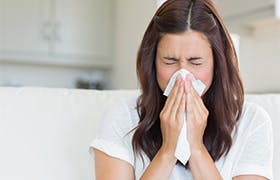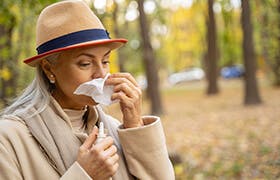
What is the science behind hay fever and similar allergies?
The immune system’s role is to protect the body from viruses and bacteria. Hay fever is caused by the immune system becoming sensitised and overreacting to a harmless substance known as an allergen.
Hay fever is extremely common, with between 10 and 30% of the world’s population thought to suffer from it. The medical term is allergic rhinitis, with rhinitis simply meaning inflammation of the mucous membrane of the nose.
What causes allergies like hay fever?
Allergies are caused when your body’s immune system wrongly identifies a harmless substance as dangerous. These substances – including pollen, dust mites, pet hair or saliva – trigger the production of immunoglobulin E antibodies (IgE antibodies). Allergies can also be caused by certain foods.
The IgE antibodies bind to the body’s defence cells (known as mast cells), which triggers the release of chemicals such as histamine that are part of your body’s inflammatory response. These chemicals act on the cells, nerves and vessels of the nose to produce the typical symptoms of an allergy – sneezing, itching, congestion and a runny nose.
Allergens exist in many different forms; and include:
- Pollens from trees, grasses or weeds
- Dust mites
- Pet dander
- Pet hair
- Moulds
- Certain foods

Flower Pollen

Tree Pollen

Dust Mites

Pet Dander

Indoors

Outdoors
What are the symptoms of hay fever?
People with hay fever can start to experience symptoms just minutes after breathing in an allergy-causing substance (allergen) such as mould spores or pollen. The body’s immune system may react with the following common symptoms:
- Sneezing
- Itchy nose
- Runny nose
- Blocked nose
- Itching of the mouth and throat
- Postnasal drip (the sensation of mucus running down the back of the throat)
- Watery, red or sore eyes

How can I reduce the risk of hay fever symptoms?
Avoiding the triggers for your specific allergy is an important part of managing it. One of the common causes of hay fever is grass pollen. It is sometimes possible to prevent the symptoms of hay fever by taking precautions such as:
- Staying indoors when the pollen count is high. Find reputable online sources that can provide the latest data on the amount and type of pollen in the air in your area e.g. https://www.metoffice.gov.uk/weather/warnings-and-advice/seasonal-advice/pollen-forecast
By clicking the link(s) above, you will be taken to an external website that is independently operated and not managed by Haleon. Haleon assumes no responsibility for the content on the website. If you do not wish to leave this website, do not click on the link above.
- Trying to avoid walking in grassy, open spaces, particularly during the early morning, early evening, and during mowing, when the pollen count is high
- Keeping windows and doors closed
- Wearing sunglasses or glasses to stop pollen getting in your eyes when you’re outdoors, and taking a shower when you get home to remove pollen from your skin
- Using a nasal wash to clean your nostrils of pollen or dust
How do I treat my hay fever?
Unfortunately there’s currently no cure for hay fever or other allergies that affect the eyes and nose. However most people are able to relieve the symptoms with different types of allergy treatment. Hay fever treatment options include antihistamines and intranasal corticosteroids, and symptom relief products:
- Antihistamines: help counter the effects of histamine, the chemical released within your body when an allergic reaction takes place. Antihistamines are found in eyedrops, nasal sprays and, most commonly, oral tablets and syrup
- Intranasal corticosteroids: can reduce the inflammation of the inside of your nose and significantly reduce nasal congestion as well as sneezing, itching and a runny nose.
- Otrivine Allergy Relief Nasal Spray can help provide relief from nasal congestion – which can be considered a frustrating symptom of hay fever as it can make the simple act of breathing more difficult

How can I manage my allergies for longer periods of time?
There are things that people with hay fever can think about adopting into their routine to manage their symptoms long-term. Your nose is the first line of defence when it comes to airborne allergens: it filters particles from the air you breathe in by trapping them in the mucus and hairs inside the nose. They are then transported to the back of your throat and swallowed or coughed out.
A build-up of pollen in the nose can affect this process and here’s where the system can break down, leading to inflammation and a blocked nose. Otrivine Natural Daily Nasal Wash is a daily solution that can help keep the nose, our natural pollution filter, working. This gentle saline formula can be used every day to help clear your nose and wash away any trapped allergens from the nose.
Is climate change making my allergies worse?
Climate change is one of the biggest issues facing our planet today. Increases in greenhouse gases are warming the world, changing rain and weather patterns and leading to more climate extremes. In the past decade, research has shown how climate change is giving rise to more opportunities for allergens to affect the lives of people with hay fever.
Warmer climates and increased CO2 levels have meant that some plant species are now able to produce more pollen over a longer season, meaning those affected by hay fever may experience symptoms for longer periods of time. In addition, more extreme weather patterns such as cyclones and thunderstorms could lead to increased flooding in many areas of the world, which will increase opportunities for mould growth.






